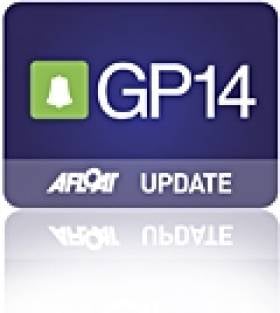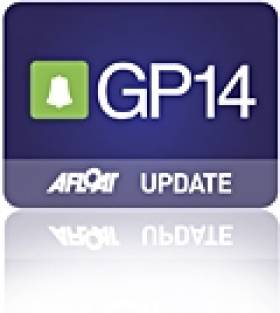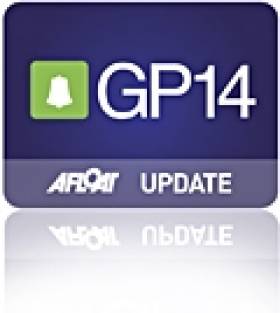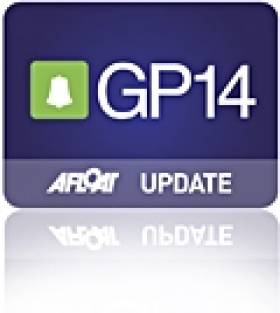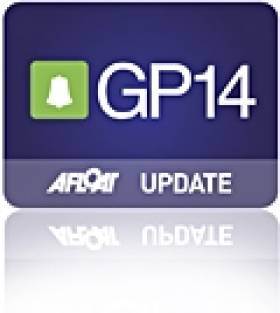Displaying items by tag: GP14
#gp14 – Fresh from their win at the GP14 O'Tiarnaigh challenge two weeks ago Shane McCarthy and Damien Bracken from Greystones Sailing Club took the honours in challenging conditions at Lough Ree Yacht club writes Keith Louden
It had been nearly 20 years since the last time the GP 14 class had visited this beautiful club and jockeyed for position on the Lough Ree Yacht Club start line. Competitors had gathered from all four Provinces displaying the geographical appeal it now has. It was also the first time a GP 14 event had been twinned with the Mirror class and was a resounding success.
After a short delay on Saturday morning to let the wind ease a little, race Officer Liam Maloney assisted by his daughter Nessa lowered the postponement flag to signal his intentions to start the 2015 Purcell Championship. Out on the water he set up triangular courses which included long beats and fast broad reaches in force 4 gusting to force 5 conditions.
In race one Shane McCarthy and Damien Bracken took advantage of the shifting conditions and established an early lead at the weather mark, with the chasing pack rounding close together they were able to extend the lead while the battle behind ensued. With McCarthy and Bracken winning, John and Donal Mc Guinness finished second and Max Treacey and Ronan MacNamara showed good early pace finishing in third.
In the silver fleet Peter fallon and James Peter Hockley who narrowly beat Simon Culley and Libby Tierney, and Bill and James Johnson respectively established an early lead.
The Bronze fleet was won by Peter and Stephen Boyle with Gareth and Richard Gallagher in second place and Adrian Lee and Edward Coyne in third.
Race two began with Keith Louden and Alan Thompson taking an early lead only to relinquish this position towards the end of the second beat to McCarthy and Bracken who had recovered impressively from a poor start to take the win. Louden and Thompson just managed to hold off the McGuinness brothers in a close battle for second place. The silver fleet was won by Cully and Tierney followed by the Johnsons. The Bronze fleet was won with a very impressive fifth overall by the Gallagher brothers followed by Lee and Coyne.
With the wind rising and capsizes increasing in race three, some crews decided to make for the shelter of the club house where soup and rolls were distributed. McCarthy and Bracken must also have smelt this because they didn't hang around long before taking another impressive win. Second was the Mc Guinness brothers and Louden Thompson in third. In the silver fleet it was Fallon and Hockley followed the Johnsons, and in The Bronze fleet the Gallaghers were followed home by Lee and Coyne.
Sunday morning began with lighter winds much appreciated by the crews who survived the Saturday afternoon. Once again the start line and the courses were set impeccably by the race officer and his team. McCarthy and Bracken came through to continue their good form from the Saturday to take the win, with Niall Henry and Ossian Geraghty who didn't make Saturdays racing taking second, third was Fallon and Hockley who also finished first in the Silver, with Culley and Tierney second and Katie Dwyer and Michelle Rowley third. Bronze was Peter and Stephen Boyle from the Gallaghers followed by Lee and Coyne.
Race five began with some large shifts which oscillated from side to side and varied in strength, however, McCarthy and Bracken won the race and with it the Purcell Trophy. McGuinnesses came second and Henry and Geraghty in third.
With McCarthy and Bracken's weekends work done they decided to take an early shower and leave the rest of the fleet to battle it out for the last piece of silverware of the weekend. With the wind dropping away during some heavy showers, then rising to planing conditions just before the next shower this was a race which was never going to be won easily. At the first gybe mark McGuinnesses led, followed closely by Treacey and Macnamara, Cully and Tierney, and Curly Morris and Laura McFarland. After seeing the first three boats sail high on the reach Morris and McFarland steered a low course and rounded the leeward mark in first place. This was a position this pair did not relinquish despite the challenge of the chasing pack and the continually changing conditions. Second was Henry and Geraghty and third was Cully and Tierney.
Overall Positions:
Gold Fleet
1st Shane Mc Carthy and Damien Bracken
2nd John Mc Guinness and Donal Mc Guinness
3rd Keith Louden and Alan Thompson
Silver Fleet
1st Peter Fallon and James Hockley
2nd Simon Cully and Libby Tierney
3rd Bill Johnson and James Johnson
Bronze Fleet
1st Gareth Gallagher and Richard Gallagher
2nd Adrian Lee and Edward Coyne
3rd Peter Boyle and Stephen Boyle
Swords Sailing Club Stages GP14 Dinghy Challenge
#gp14 – The GP14's kicked off the season with the Riocard O'Tiarnaigh Challenge sailed at Swords Sailing Club on the weekend of the 18th and 19th of April. A total of 20 boats turned up to compete for the championship which was run in individual fleets Gold, Silver and Bronze over the Saturday and Sunday. The top four in each fleet qualify for the final three race sail-off to determine the overall winner on the Sunday afternoon. Results downloadable below as a word file.
With a steady 13 knot breeze the bronze fleet were first to take to the water and the young Gallagher brothers Gareth and Richard showed early form to lead the first race from start to finish. In the silver fleet it was Simon Cully paired with his old crew Richard Street who took line honours while in the Gold fleet it was the Tim Corcoran and Brendan Brogan, back after a year's sabbatical who showed the early form and took the first race.
As the day progressed it was the young Gallagher brothers from Culmore who dominated the bronze fleet winning all but one of the six races on the Saturday. It was young Peter Boyle crewed by the auld fellow Stephen who won the last race of the day to hold second place overnight in the bronze fleet. Third place overnight was Adrian Lee and Edward Coyne from Youghal. Adrian and Edward sailed a consistent series finishing either second or third in each of the six races.
The silver fleet was hotly contested with Simon and Richard taking three of the six races but two DNS meant they were relegated to third overnight. Colman Grimes and David Lappin took two of the six races and were the overnight leaders in the silver fleet. Bill and James Johnson won one of the six races and finished the day in second place.
Despite Tim and Brendan's early showing it was Niall Henry and Ossin Geraghty who dominated the first day in the Gold fleet taking two of the first six and finishing second in three of the others. Shane MacCarthy and Damian Bracken finished the day in a creditable second place taking one of the six races and finishing second and third in the rest. The Mc Guinness brothers held third place overnight with consistent top four finishes.
On Sunday morning there was still three races to sail in the qualification series and qualification open to almost all the fleet. The Gallagher brothers, who after their strong showing on the Saturday had already qualified for the final didn't need to sail but decided to go out and get a feel for the course in preparation for the final. They sailed the first race and then came ashore to rest while the other battled it out for the remaining qualification spots. Peter and Stephen Boyle, Adrian and Edward from Youghal and Michael Collender with Brian Walker from Mullingar took the other qualification spots for the final. In the silver fleet it was Colman and David, Simon and Richard, Bill and James with Gerry Gilligan and Lucia Nicholson who qualified for the silver fleet. In the gold fleet the qualification places went to Niall and Ossian, Shane and Damian, John and Donal with Tim and Brendan taking the final spot.
The first race in the final saw Simon and Richard a little to eager to start and earned a black flag for their troubles. Niall and Ossian lead at the weather mark and held it all the way to the finish. Shane and Damian were second with Tim and Brendan third. Race two saw a reversal in the top two positions with Shane and Damian taking the first place and Niall and Ossian taking second. With double points for the last race, the overall result would depend on which of the two inform teams could come out on top. In the end it was Shane and Damian who won the race and the championship with Niall and Ossian finishing second overall with the McGuinness brothers taking the last of the podium positions. Colman and David took the top honours in the silver fleet while Adrian and Edward were the overall winners in the bronze fleet.
#gp14 – The ideal number of six GP14 dinghies with 12 keen sailors ranging in age from 14 to 20 and from four different clubs participated in Easter Training organised under the burgee of Youghal Sailing Club (formed only 4 months) on Sat, Sun and Mon. Spring had arrived on call only two days before and provided sunshine and light breezes, pretty much ideal for Troy Mc Namara our lead coach to set things up ashore at out temporary campervan club house on Ferry Point, an ideal location in the centre of this beautiful natural harbour.
Saturday's on the water exercises was done inside the wide inner bay where the Blackwater estuary sweeps east after the road bridge and before the gravel/sandy spit which is Ferrypoint, with a break in the middle for hot chocolate and fresh cut sambos provided by Una and Ruth Lee [Greystones and Youghal] and tips and entertainment from Troy. The evening featured Pizza and soft drinks in an activities hall and debrief from Troy armed with lots of film shot during the days action.
Sunday morning's sailing was done in sand ballast bay just to seaward of Ferrypoint and the sunny afternoon was spent tacking in a restricted channel between safety boats and towed buoys and doing starts and triangles out in the main bay off the beach. Evenings debrief once more featured film from the day and pizza that went down very well once more.
Monday dawned very foggy and down at base on Ferrypoint after a few halyards were restrung Troy gave an extended briefing and meteorological explanation while facing a thick fog bank to seaward until eventually he realised the fog had lifted sufficiently in the inner bay behind him to allow launching. Enthusiasm was so high that what was to be just a morning session on the water got extended to coming in for a quick lunch and getting out for another hour of starts and beats. To see everybody cross the line on the gun and get to the weather mark and back in a tight bunch with smiles on their faces and lots of friendly banter so many times, was proof of success and was just what is needed to give the feel good feeling that will keep this gang sailing and hopefully help Youghal focus again on the sea.
Without an existing sailing club or training centre, sailing in this historic sailing ship port is making a comeback spearheaded by schoolboy Adrian Lee who's passion for the sea led him to an old GP14 he kept moored in the harbour Moby Dick was filmed in and from there, to growing a fleet of 12 GPs in 3 years and travelling to GP circuit events as far away as Sligo and Donaghadee to gain experience. GP's have proved ideal for the kind of adventure sailing and racing done by the hardy youngsters of Youghal with their great seafaring tradition and can do attitude.
Just Who Do The Irish Sailing Association Think They Are?
#irishsailing – Ireland's national sailing authority has been going through turbulent times in recent years. With unprecedented expansion of ISA staff numbers as the country revelled in the boom years of the Celtic Tiger, the arrival of the inevitable and abrupt financial downturn found an Association bloated, unfit to cope, and out of touch with ordinary sailors.
High profile events, top level training and international participation had become so dominant in the ISA's range of activities that many of the ordinary sailors of Ireland already felt the Association was no longer relevant to their own low key personal pursuit of friendly sport afloat.
When the crash came, it led to a marked decrease in active sailing numbers as disposable incomes fell away. People focused on keeping their jobs and businesses afloat rather than their boats sailing, while many promising young sailors were forced to emigrate.
This new reality was reflected by the growing disillusion of club officers, who saw their membership subscriptions decreasing even while the ISA – which is largely reliant on subvention from the clubs for its own income – seemed always to be looking for more money. And at the height of the boom years, when all the major clubs had put through significant expenditure in developing their facilities to international standards, the ISA had shown its lack of contact with the reality of club life by proposing its own stand-alone National Sailing Centre in Galway, a facility which would in effect have been run in rivalry to the main clubs. To the mutterings in the grass roots were added the rumblings from above as major clubs threatened to withhold their annual payment to the ISA unless real reform was initiated. W M Nixon takes up the story.
In a classic grass roots revolution, club sailors Norman Lee from Greystones in County Wicklow and Bryan Armstrong from Sligo were at first rebuffed when they tried to voice their concerns about the ISA's increasing irrelevance to the needs of the vast majority of sailing enthusiasts, people at local level who were doing their very best to keep the sport alive through torrid times.
The Irish sailing community now owes these two men and their supporters a debt of gratitude, for they believed in what they were saying and they refused to be turned aside. Eventually, in November 2013 moves were in place to establish a Review Group for the urgent analysis of all ISA activities, and its personnel drew comprehensively on Ireland's remarkable pool of people with hands-on experience of running successful sailing events and organisations.
It was chaired by Brian Craig of Dun Laoghaire who has headed up the organising team on more major and notably successful international sailing events in Dublin Bay than probably anyone else, and its able personnel included two former ISA Presidents - Roger Bannon of Dun Laoghaire and Neil Murphy of Malahide and Howth - who had both been noted for their skill in running a tight ship when they were in charge. With them was highly regarded International Race Officer Jack Roy of Dun Laoghaire, and renowned sailmaker/activist Des McWilliam of Crosshaven, who each year is inevitably seen in busy involvement afloat in more Irish sailing centres - large and small - than anyone else in the boat world.
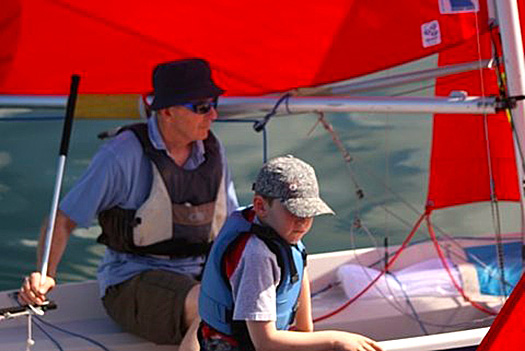
Bryan Amstrong of Sligo on the helm for a Mirror race
Also on board was one of the men from the barricades, Bryan Armstrong of Sligo. His background in a relatively remotely-located club which nevertheless has a long and distinguished sailing history made him uniquely qualified to voice the concerns of the grass roots. And we have to remember that all these people were giving voluntarily and generously of their time to this project in a period when Irish life was largely a matter of just getting through each day, while staying economically afloat was something of an achievement.
Primarily, the Review Group's function was to analyse the Association work on behalf of ordinary club sailors, as it was agreed that the Olympic and High Performance Divisions of the ISA's activities – which receive direct Sports Council grants – were in effect functioning as a different entity.
The Strategic Review Group was still work in progress when the ISA acquired a new President in David Lovegrove in March 2014, but by August the SRG published proposals which led to the setting up of a more formal body, the Planning Group. If this seems like a case of kicking the can down the road, it was anything but - these were people in a hurry, they'd got through the first stage of analysing areas where action was required, now they had to be more structured in coming up with clearcut ideas and concrete proposals.
This new Planning Group, which went into action in early Autumn 2014, was chaired by Neil Murphy, and its members included ISA President David Lovegrove, ISA Board Member Brian Craig, Ruth Ennis, Peter Redden, Sean Craig, and ISA CEO Harry Hermon, with noted Dun Laoghaire events administrator Ciara Dowling to provide administrative support.
They had their draft plan ready by mid-December 2014, and on January 21st 2015 Neil Murphy and his group publicly unveiled their analysis and proposals for the first time at a well-attended and very representative meeting in the Royal St George YC in Dun Laoghaire.
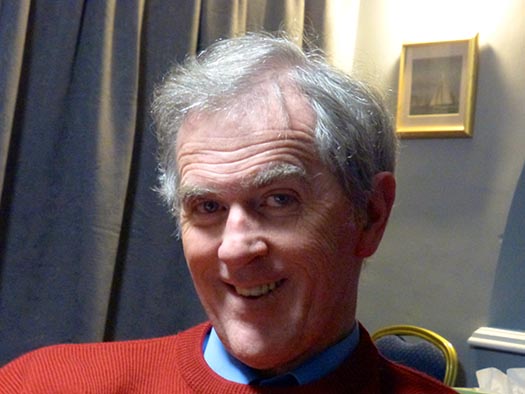 Neil Murphy is a former ISA President who, in addition to extensive experience as a Race Officer, is a typical club sailor, racing a Puppeteer 22 out of Howth. Photo: W M Nixon
Neil Murphy is a former ISA President who, in addition to extensive experience as a Race Officer, is a typical club sailor, racing a Puppeteer 22 out of Howth. Photo: W M Nixon
While those involved in setting the ISA on a healthier course are mostly working on a voluntary basis, it has to be said that the PowerPoint presentation and the printed material was of the highest professional class. In fact, it was much better than many professional shows I've been to, and the level of thought which went into a wide range of questions from the floor answered by Neil Murphy, Brian Craig and David Lovegrove generated a growing level of goodwill which concluded with Norman Lee voicing his congratulations and good wishes for this continuing process in which he and Bryan Armstrong had played such a key role.
So now we move on to the next stage – taking the ideas to the rest of the country. Doubtless you'll have noted the double meaning in titling this piece 'Just Who Do The ISA Think They Are?' In a first interpretation, that question is the one for which, let's hope, we are all now involved in working together in providing and implementing a satisfactory answer.
But equally, as the ISA Road Show gets out of Dublin to take this excellent presentation to a public meeting in Cork next week (it's in the Rochestown Park Hotel on Tuesday, Feb 17th, 7.0 pm to 9.0 pm) and then Galway the week after (Galway Bay Sailing Club, Tuesday 24th February 7.0 pm to 9.0pm), they'll be taking themselves into areas where experience of sailing administration long pre-dates the establishment of organised sailing on Dublin Bay.
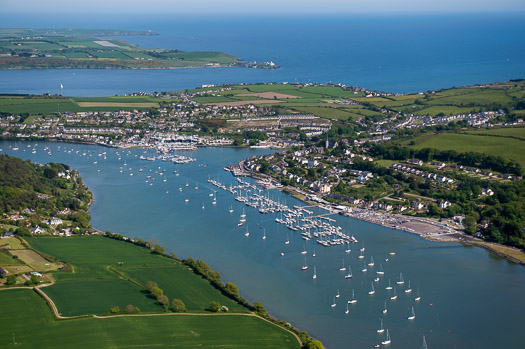 Crosshaven in the summer time. When we look at the natural advantages to be found here, it's little wonder that structured recreational sailing on Cork Harbour long-pre-dated any organised sport on Dublin Bay. Photo: Robert Bateman
Crosshaven in the summer time. When we look at the natural advantages to be found here, it's little wonder that structured recreational sailing on Cork Harbour long-pre-dated any organised sport on Dublin Bay. Photo: Robert Bateman
So you might well ask just just who do they think they are, these people from Dublin, going down to Cork to try to tell them how sailing should be organised? The nerve of them, doing it in a place where they've had organised sailing since 1720, and where the two biggest clubs – the Royal Cork and Kinsale – are both mighty establishments of international sailing repute which would remain so even were the ISA to disappear overnight in a puff of smoke...
And as for going west along the road to Galway, that will take them through Athlone where the Lough Ree Yacht Club dates back to 1770, while on the west coast the Royal Western of Ireland YC at Kilrush traces its origins back to 1828. Equally, further north along the Atlantic coast Sligo YC dates back to 1821, and in Lough Erne the club began in 1820. Yet the first club on Dublin Bay, the Royal Irish, only began as recently as 1831, and even then it barely hung in and had to be revived in 1846, with the pace being set in the meantime by the Royal St George YC, founded 1838.

Kinsale is another harbour which seems to have been designed with sailing primarily in mind. Photo: Kevin Dwyer/courtesy ICC

Kilrush on the Shannon Estuary had a club in being before there were any sailing institutions on Dublin Bay. Photo: W M Nixon
So in terms of sailing administration history, Dublin and Dun Laoghaire are only Johnny-come-lately places by comparison with just about everywhere else in Ireland. Yet thanks to the inevitable dominance of economic development, population growth and the strengthening centres of political power, we now find that sailing administration and decisions of national import are emanating from a place that, in terms of natural sailing advantages, lags far behind the rest of the country.
Oh for sure, Dun Laoghaire Harbour is a fabulous artificial amenity, and the advent of the new marina at Greystones has already been seized upon as greatly increasing the "cruising" options of Dublin Bay. But let's face it, Dublin Bay is really only good for racing, specific day sailing and training, whereas Cork Harbour and Kinsale provide such a variety of opportunities for interesting race courses, mini-cruises with multiple destinations and what have you, that in effect they're not just in a different part of the country – they're a different country altogether.

Dun Laoghaire is a totally artificial facility, and sailing options on Dublin Bay are limited. But it's inescapable that this is the primary point of leisure access to the sea for Ireland's largest and most affluent population. Photo: Kevin Dwyer/courtesy ICC
All of which adds to the difficulties of creating a meaningful national authority with which every sailing person can identify.
This business of Dublin v The Rest is not unique to sailing, of course, but when you have a specialist sport with multiple sub-branches of activity, the problem is exacerbated.
So please bear this in mind if you take yourself along to the meetings in Cork or Galway during the next ten days. This really is a genuine attempt to base the ISA within the sailing community at an everyday level of usefulness to all, with scope for growth while enhancing existing structures, and input from the sailing community at this stage will help in developing the ideas and initiatives proposed.
While the draft ISA Strategic Plan 2015-2020 very definitely puts the emphasis back on to the need for healthy well-run clubs as the basis for the sport, there was initially a feeling at the meeting on January 21st that the new-look ISA is not supportive of commercial sailing schools. In fact, what the new-look ISA hopes to do is encourage training schemes within clubs, while at the same time supporting commercial sailing schools where the demand is such that no club could realistically cope while maintaining its essential club ethos.
Going into this in more detail in a personal meeting this week with Neil Murphy, who is a Chartered Quantity Surveyor, we talked around the fact that a thriving club scene is central to the spirit of Irish sailing, and he was musing on the success of Sutton Dinghy Club where Hugh Gill heads up what is in effect a commercial sailing school within a club setting.
In fact, what Murphy would hope to see emerge at larger population centres is sailing's equivalent of the public golf course. Anyone who has used a public golf course will be aware that the proprietors are usually mustard keen to encourage the formation of a "club" within their customer base, and there is no reason why this shouldn't eventually take root in Irish sailing, providing access to sailing at a fraction of the cost of joining an established club.
It's not something which can realistically be objected to by established clubs trying to protect their own membership, as the people who would use a "public sailing club" would be those who simply couldn't afford to go sailing at all in the current traditional club setup.
Nevertheless support for the established club setup is central to the new Strategic Plan, and the provision of Regional Development Officers to serve clubs directly is very much to the fore in the new thinking. But in looking over the figures published with the report, it's good to note that the ISA works with no less than 80 recognised training centres, while an encouraging statistic is that there are now 24 secondary schools in Ireland which include sailing as a regular part of their curriculum. Admittedly it's a long way from the French setup where every schoolkid is entitled by law to one week of sailing and one week of skiing per year, but in a country where an aversion to being on the water used to be thought inevitable, it's a step in the right direction.
All these considerations of inexpensive sailing are a whole world away from the stories of recent weeks and days about the ISA's High Performance Division seeking a fund-raising executive who will be tasked with finding €2.75 million per annum through philanthropic and other donations in order to help the funding of top level campaigns which we're not allowed to call Olympic campaigns, as apparently that is copyrighted by the Olympic Council, so we call them High Performance instead.
But apparently Government departments aren't restricted by this limitation on the use of the word Olympic, for it was bandied about like nobody's business in this week's news that the government is spending mightily through the Sports Council, with sailing being number three in all Ireland in terms of current Sports Council funding, with a total tag of €1,289,900.
Of course it's not all for specifically Olympic sailing, but it covers 103 sailors from Optimists to the Olympics. Which is fine and dandy for those who are mad keen to race at the highest level, but most sailors in Ireland are much more interested in performing well within their chosen area and boat class, but with sailing being just part of a reasonably civilised and well-balanced life.
And as became evident at the meeting on January 21st, there's an increasing number of people who feel that sailing needs to realise that there's a sizeable population out there of folk who'd like to go sailing, but don't feel the almost religious vocation to own a boat.
With the rapid expansion of sunshine sailing holidays with boats and equipment readily available for hire at the destination, there's a strong feeling there's a real need for more of this in Ireland, even if we can't guarantee the sunshine. The suggestion brings us back to both the "public sailing club" concept, and the growing realisation by established clubs that they have to reach out to potential members by having boats available for sailing on a trial basis.

The Affordable Sailing Team – Norman Lee (right) with his brother Ken beside their campervan at last year's GP 14 Worlds at East Down YC on Strangford Lough. Photo: W M Nixon
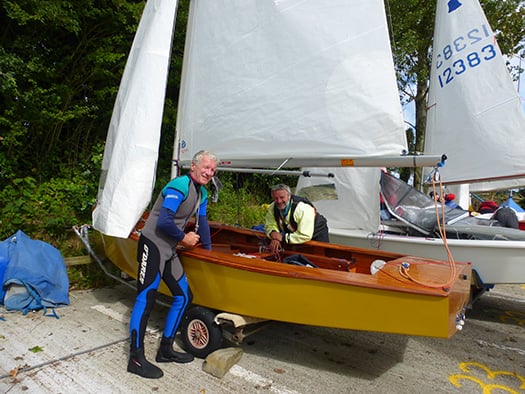
With their own very high can-do standards of boat maintenance, Norman and Ken Lee can keep their GP 14 in the competitive frame. Photo: W M Nixon
That said, the need to own one's own boat and tune and tinker with her to your heart's content is what sailing is all about for many of us, and Norman Lee is a classic case in point for this approach. He claims that his sailing costs him just €600 per year, though that of course is after he has paid for his well-tuned GP14, and he has long since written off the cost of the vintage camper-van which is home to the Lee Equipe when they hit the campaign trail.
Nevertheless the entire setup has to be outstandingly good value, and doing it in such economical style is part of the fun of it all. So when someone with Norman Lee's approach to sailing is prepared to get up at the big ISA public meeting in Dun Laoghaire and congratulate the team who have been working on the reforms which he and Bryan Armstrong set in train, then that is approval of a high order.
And as for just who or what is the ISA, can we maybe agree that ideally we all are the ISA, every last one of us who goes sailing or is even just interested in the sport, and it's up to us to keep it in line and encourage it to identify with and serve the ordinary sailor every bit as much as the high-flyer.

Private pleasure.....the 2014 GP 14 Worlds at East Down YC is about as high as many Irish sailors would expect or want to aim, and many are content with much lower-key regular club sailing. Photo: W M Nixon
Irish Sailing Review 2014: A Year Of Hope, Regeneration & Success
#irishsailingreview – 2014 has been the year in which Irish sailing regained its international confidence afloat by re-capturing the Commodore's Cup. Having won it in 2010, the national economic collapse prevented any defence in 2012, but in July 2014 the stain and shame of 2012's non-appearance was emphatically wiped from memory with a convincing team victory led by Anthony O'Leary.
Ashore meanwhile, it had taken longer in some quarters for the economic realities to become fully evident and accepted. But for the Irish Sailing Association, a grassroots revolution within the national authority and sailing in general in 2014 resulted in a root-and-branch analysis of the workings of the Association, which had been heading towards financial disaster through a combination of over-staffing, grandiose schemes of expansion and empire-building, and an emphasis on activities and programmes which were remote from the needs of ordinary sailors throughout Ireland.
It took six months to turn round the course of the Association. But on November 5th 2014 the new ISA President, David Lovegrove, was able to announce a far-reaching re-structuring which is already resulting in a leaner and fitter body, better able to provide a realistic service for clubs and the huge diversity of recreational activity on Ireland's seas and lakes.
While all this high profile activity and action has been taking place at international and national level, those Irish sailors who had managed to keep up their sport through the financial downturn – albeit in often very reduced circumstances – continued to sail their boats with the attitude that, while the economic situation was disastrous, it mustn't be allowed to become serious, and in some ways the best course out of the recession was to sail through it. W M Nixon casts an eye over the year's main activities.
In the Irish sailing year, Christmas Day is New Year's Eve. Next morning, on December 26th – St Stephen's Day or Boxing Day or whatever you're having yourself – the annual 628-mile Sydney-Hobart Race starts. It may be on the other side of the world, and it may still be in the very last days of the old year. But Irish interest at home and in Irish-Australia is always high, and in the sailing community it's seen as the start of the new season.
December 26th 2013 was in line with this, as we'd ex-Pat superstar Gordon Maguire – a previous Hobart race overall winner – very much in contention with Matt Allen's totally new Carkeek 60 Ichi Ban, we also had Sean McCarter of Lough Swilly YC skippering Derry/Londonderry in the warmly-welcomed Clipper Fleet of 70-footers designed by Tony Castro (formerly of Crosshaven) which were taking in the Hobart race as part of their global circumnavigating race, and we'd Barry Hurley and Kenny Rumball on the First 40 Breakthrough knowing that in the 2010 Hobart race, the new design's race debut, First 40s had taken first and second overall.
In a rugged race in which the wind got up to gale force and more towards the end, it was a much-loved hundred footer, Bob Oatley's continually-modified Wild Oats XI, which stole all the headlines with line honours, a course record, and a class win. Irish hopes were best met by Sean McCarter, who logged a very clear win in the Clippers. As for Ichi Ban, while she was third in IRC Div 1 and 8th overall, it wasn't quite a stellar performance, reinforcing the views of those of us who think the boat may be just a little too plump by today's lean and hungry standards. And aboard Breakthrough, they'd 8th in class and 29th overall, a useful performance perhaps, but Barry Hurley will be back on December 26th 2014, boosted by his first in class and second overall in October's Middle Sea Race.
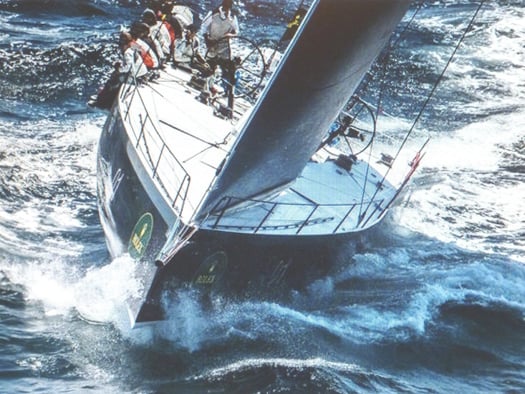
Matt Allen's Ichi Ban in the Rolex Sydney-Hobart Race of 2013, with Gordon Maguire as sailing master. To some observers, the very new Carkeek 60 seemed distinctly plump in her hull form forward compared to her closest competitors
In late January 2014, attention focused on the Quantum Key West Regatta in the Florida Keys, where Irish Olympic sailor Peter O'Leary of Cork was on the strength of New York art dealer Marc Glimcher's completely new and very potent looking Ker 40 Catapult. The boat did the business afloat in Florida, but further business was done ashore, as Anthony O'Leary himself was in Key West to see if he could sign up Catapult to be the secret ingredient in Ireland's Commodore's Cup team, for which at that stage the only certainty was his own older Ker 39 Antix. There seemed to be agreement, but in the volatile world of international trading and snap decisions in which top modern sailing operates, there can be sudden reversals of fortune, and O'Leary later admitted that until Catapult was actually unloaded from a ship in Europe, he hadn't been a hundred per cent certain she'd show.
Key West had further Irish interest in that veteran skipper Piet Vroon's Ker 46 Tonnere de Breskens – a former Round Ireland Race winner – was another star in the show, but much was to happen in Irish sailing before the Round Ireland 2014 got under way in Wicklow on June 28th.
With March slowly showing signs of Spring, university racing came centre stage, and it was University College Dublin which came through on top to qualify as Ireland's representatives in the Student Yachting Worlds in France in October, the team led by Philip Doran.
Another team was emerging as the Irish Cruiser Racing Association (ICRA) announced that our Commodore's Cup squad would be Anthony O'Leary's Ker 39 Antix, Marc Glimcher's Catapult, and the Grand Soleil 43 Quokka chartered by Michael Boyd and Niall Dowling, with Anthony O'Leary as team captain. He in turn would be supported by the shore management team, for a very intense week of racing, of Barry Rose and Fintan Cairns, with Mike Broughton in what would prove to be the particularly onerous task of Team Meteorologist.
As 2014 was exactly midway between two Olympiads, top level international dinghy sailing to Olympic standards might have been expected to be on the back burner. But Ireland's Olympians were very much on track on the international scene, and busy with their own programmes which culminated in the ISAF Worlds in Santander where Olympic places in Rio de Janeiro for 2016 were secured by James Espey in the Laser, Ryan Seaton & Matt McGovern in the 49er, and Annalise Murphy in the Women's Laser Radial. All were of course also seen in other boat types from time to time, with Annalise in particular bringing some glamour to the growing class of foiling Moths in Ireland.
Annalise on the foiling Moth
Other top international women sailors had descended on Ireland in early June with the ISAF Women's Match Race Worlds at Crosshaven. It's very much a specialist sailing interest, but aspiring Irish woman sailors attracted to this discipline found that this successful regatta provided some very useful networking contacts and future crewing possibilities, while the racing itself saw Sweden's Anna Kjellberg of the Royal Gothenburg YC become the new champion after defeating Camilla Ulrikkeholm of Denmark in the final.
In an entirely different area of sailing and life afloat, the traditional boat scene had come early to life with the Baltimore Wooden Boat Festival at the end of May. In the Irish climate after a particularly damp Spring, it reflected great credit on those involved that there was such a good turnout, ranging from the Shannon Gandelows from Limerick recently returned from their historic visit to Venice, through the many restored classic yachts of the region, also including the lovely Shannon cutter Sally O'Keeffe from Kilrush, and going on into the restored traditional mackerel and lobster yawls which make West Cork their home.

Shortly after their historic visit to Venice, the Shannon gandelows built by the Ilen School took part in the Baltimore Wooden Boat Festival at the end of May. The gandelow here, rowed by Liam O'Donghue, Anthony Kenny and Robert Samlle, is headed across Baltimore Harbour towards the gaff ketch Sile a Do.
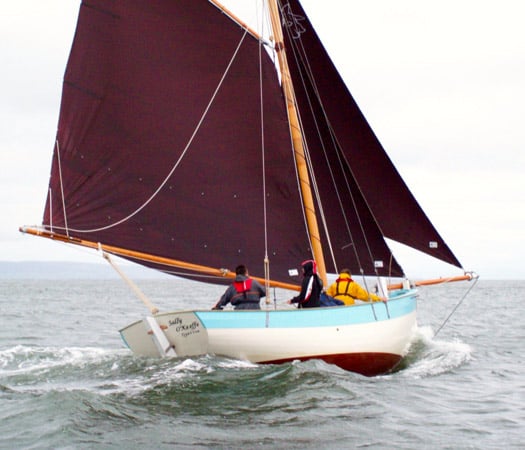
The pride of the Shannon Estuary - Sally O'Keeffe was built in a community effort in Querrin on the Loop Head peninsula.

The traditional lobster boat Saoirse Muireann (left, Cormac Levis) and the mackerel yawl An tiscaire (Uilliam O'Lorcain) are a familiar sight in the waters of West Cork. Photo: Brian Marten
They were to re-appear in even greater numbers at the Ballydehob Gathering of the Boats in early August, a month during which the classic Galway Hookers of the West Coast were at their busiest on their home Atlantic waters, but the East Coast also had its moments with the Riverfest in Dublin's Liffey in early June seeing traditional and classic craft in a lively mix.

Sails in the City – two of the 1898 Howth Seventeens racing in the heart of Dublin in the Liffey Riverfest. Photo: W M Nixon
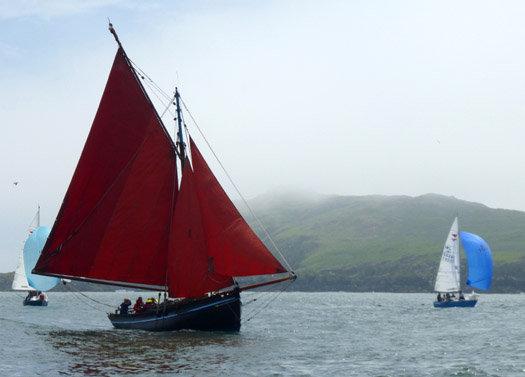
It could almost be Connemara, were it not for the Puppeteer 22s – the Galway Hooker Naomh Cronan in the new Classics & Traditional Division in Howth's annual Lambay Race, which was marking its 110th anniversary in 2014. Photo: W M Nixon
Indeed, so strong is the growing interest in classics and trads on the East Coast that to celebrate the centenary of the Lynch family's Howth 17 Echo (one of the newest of the class, the most senior ones were built in 1898) Howth YC provided a traditional Lambay Race course – simply up around Lambay and back to Howth Harbour – for the Seventeens and a new Classics Division, with the Howth 17s seeing the first two places taken by 1898 boats – Rita (John Curley & Marcus Lynch) and Aura (Ian Malcolm) – while Old Gaffers Association International president Sean Walsh won the classics with his Heard 28 Tir na nOg from the Clondalkin team's Galway Hooker Naomh Cronan. As for the overall prize among the large fleet of more modern boats sailing their more complex course, that was won by Colm Bermingham's Bite the Bullet.
The countdown to the Commodore's Cup had continued with inspirational performances by Anthony O'Leary in the Easter Challenge in the Solent, where he won his class with Antix, and then in June he did the same again with the British IRC Championship. Back home, ICRA held their Nationals with the Royal Irish YC in Dun Laoghaire in mid-June, and out of a fleet of a hundred plus boats it was the vintage Marcus Hutchinson/Rob Humphreys designed Quarter Tonner Quest (Jonathan Skerritt, RIYC) which was best overall scorer, a notably impressive performance also being put in by the Ker 36 Jump Juice (Denise Phelan) from Crosshaven.

The 27-year-old Quarter Tonner Quest (Jonathan Skerritt) was overall winner in the ICRA Nats at the RIYC in Dun Laoghaire. Photo: David O'Brien

Downhill battle at the ICRA Nats with the Mills 36 Raptor (ex-Aztec) in foreground, while beyond is Peter Dunlop of Pwllheli's J/109 Mojito against the XP33 Bon Exemple (Colin Byrne, RIYC). Photo: Davd O'Brien

The Ker 36 Jump Juice (Denise Phelan) dominated Class 0 at the ICRA Nats. Photo: David O'Brien
The end of June, and it was Round Ireland time. Thirty-six boats started from Wicklow, 33 finished in a race which was mostly on the slow side, with mid-size boats having their day. The winner was Richard Harris's Sydney 36 Tanit from Scotland by just six minutes from the home favourite, Liam Shanahan's J/109 Ruth from the NYC in Dun Laoghaire. The French defending champion, Laurent Gouy's Ker 39 Inis Mor which sails in Ireland under the burgee of Clifden Boat Club, placed third while Frank Doyle of Cork, second generation round Ireland aristocracy as son of Denis of Moonduster fame, was fourth with his A35 Endgame.
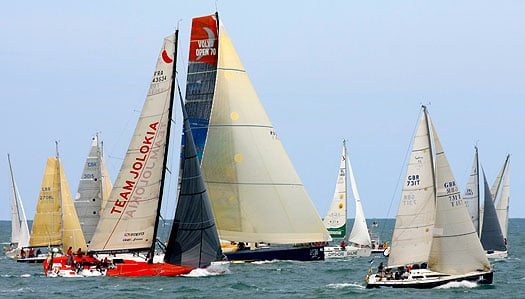
The start of the Round Ireland Race 2014 well illustrates the eclectic nature of the fleet. In right foreground is Richard Harris's Sydney 36 Tanit which was overall winner by just six minutes from the J/109 Ruth (Liam Shanahan), just beyond with the black jib, while the Volvo 70 Monster Project (David Ryan) comes thundering through the fleet at the beginning of a performance whch would see her take line honours win and thd class win in the CK Div.. Photo: Kevin Tracey
The same weekend as the Round Ireland race started, Lough Foyle sent the Clipper Fleet on their way after a week's festivities in Derry/Londonderry, made even more festive by the fact that Sean McCarter and his crew with the home town's boat had crowned their win in the Sydney-Hobart race with victory in the Transatlantic leg to Derry.
Clipper fleet in Derry
Crosshaven fairly leaped to life with Cork Week in July, and after several hitches in various boat-shipping plans, it was notable as the first time the Irish Commodore's Cup Team 2014 were seen together, and mighty impressive they looked too, with Quokka proving best on the Cork Week leaderboard.
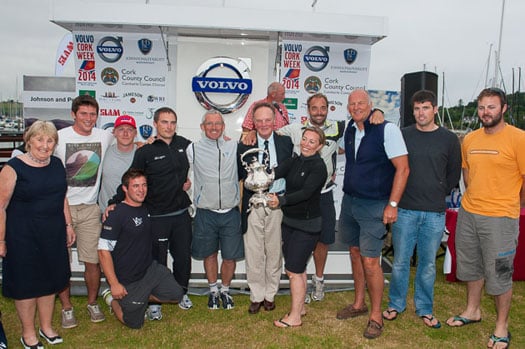
Michael Boyd (centre behind cup) and his Quokka crew, a member of Ireland's Commodore's Cup team, were overall winners of Cork week 2014. Photo: Bob Bateman
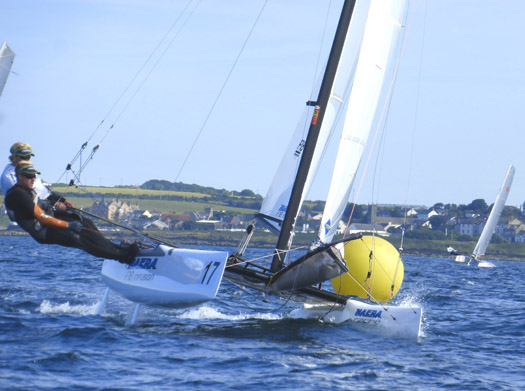
In the F18 Worlds at Ballyholme, Dutch skipper Gunnar Larssen (crewed by Ferdinand van West) is seen here putting in the smooth performance which saw him winning the worlds at his thirteenth attempt. Photo: W M Nixon
While all this excitement in racing boats with lids was building on the south coast in July, up north on Belfast Lough at Ballyholme the F18 Worlds were held for one of global sailing's most popular catamaran classes. Though the entry of 56 boats didn't match the 150-plus entries they get when the class has its worlds in its Mediterranean heartlands, the sailing was good and a popular winner emerged in longtime F18 sailor Gunnar Larsen, who is Dutch despite his Scandinavian name.
Dinghy attention was also very closely focused on Dublin Bay, with an enormous fleet of Optimists at the Europeans hosted by Royal St George YC from 12th to 20th July, and Dun Laoghaire really showing what it can do in being a major international regatta centre. France's Enzo Balanger was tops from Sweden's Kasper Nordenram, while best of the Irish in the Gold Division was Royal Cork's James McCann in tenth – not surprisingly, he was to go on to win the Nationals at his home club in August.

Nations from across Europe and beyond were at the Optimist Euros at Dun Laoghaire

Finn Lynch racing at Douarnenez in France where be became the new U19 Laser Standard world championPhoto: Trevor Millar/Sail Coach
On the broader international scene, former Opty stars Finn Lynch (National YC) and Seafra Guifoyle (Royal Cork) were to turn in outstanding results during 2014, with Guilfoyle firmly in the frame through the ISAF Youth Worlds in the Laser, eventually coming home from Tavira in Portugal with the Silver, while Finn Lynch was on top form to clinch the Gold in the Under 19 Laser Standard Worlds at Douarnenez in Brittany.
Back aboard the boats with lids, late July had brought the Commodore's Cup in the Solent, and if anyone out there doesn't know who won, we'd like to hear from them, as the state of total seclusion which this implies is surely something which could be packaged and marketed to our hyper-informed and over-crowded world. The comprehensive Irish victory just seems better and better with the passage of time, and for Anthony O'Leary it was the highlight of a fantastic season which in September was to see him win the Helmsman's Championship of Ireland (admittedly by just a whisker) in J/80s in Howth to set up a national double for Royal Cork, as young Harry Durcan of Crosshaven was winner of the Junior Helmsmans. O'Leary meanwhile went on to win the 1720 Nationals in Baltimore later that month, and then in November his beloved Antix was named RORC Yacht of the Year.

Antix in the Commodore's Cup, hanging in well coming to the weather mark to stay ahead of the newer Ker 40 Cutting Edge. Photo: Rick Tomlinson)
Even as Antix and her team mates were racing on towards glory in the Solent, in Clew Bay the West of Ireland Offshore Racing Association (WIORA) were staging their annual championship at hospitable Mayo SC, and it saw a good spread of results, with the overall winner being Galway's Liam Burke with his Corby 25 Tribal, while the runner-up was the McGibneys' Dehler Optimum 101 Dis-a-Ray, which sails under the Foynes YC burgee, but her home port is Tarbert further west along the Shannon Estuary.
August was busy with events for enjoyment. Eighty boats raced in Calves Week in West Cork, which has now been compressed to a four day regatta which means, as one sage family man observed, that you can take a house in Schull for a week's holiday, and then just as the wife and kids are getting fed up with having the ould fella always about the place, doesn't he absolutely have to go off and spend the last four days of the holiday sailing with his mates? That one of the top boats was Colman Garvey's True Penance maybe says it all.

Calves Week 2014 entries were up 25% in 2014. Photo: Bob Bateman

The GP14 Worlds at East Down YC in Strangford Lough launched a hundred boats every day in smooth style. Photo: W M Nixon
The biggest dinghy event of all (other than the Laser Nationals, which as ever are in a league of their own) was the GP 14 Worlds in mid-August at East Down YC in Strangford Lough, which had its excitement in a sudden storm on the Monday, but it all turned out okay. Boats involved were just over the hundred mark, the best boats were built in Northern Ireland by Alistair Duffin, and winners were English crew of Ian Dobson and Andy Tunnicliffe from Burwain, while top Irish were John and Donal McGuinness of Moville in Donegal, they were sixth.
At the other end of the intensity scale, down in Howth they had their first cruiser-racer two-hander for the Aqua Restaurant Challenge. Despite very restrained pre-publicity, it attracted 34 boats for a race round Lambay and the Kish. Stephen O'Flaherty's elegant Spirit 54 Soufriere, fresh from a win in the Panerai Classics in Cowes and co-sailed by David Cagney, took line honours and almost won, but the vintage Humphreys Half Tonner Harmony (Peter Freyne and Jonny Swann) just pipped them at the end.
Sailed in summery weather, the new Howth two-handed was about as different as possible from another two-handed experience in August, that of Liam Coyne (NYC) and Brin Flahive (Wicklow) in the 1800 mile RORC Seven Star Round Britain and Ireland. They didn't have to be two-handed, there were fully crew boats involved including the 70ft–trimaran Musandam in which Ireland's Damian Foxall played a leading role in taking line honours in record time, but aboard the First 36.7 Lula Belle the Irish duo just toughed it out despite sailing the last 500 miles with virtually nothing functional, they simply decided to see it through, and to their amazement found they'd won Classes V & VI.
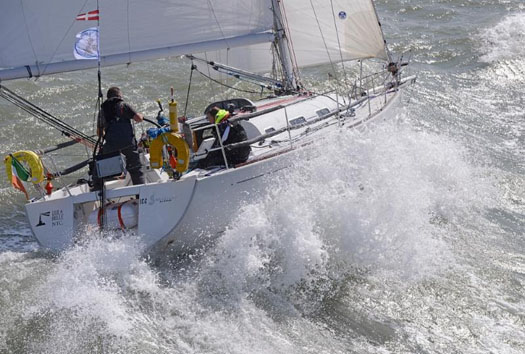
Lula Belle on her way out of the Solent with 1800 miles to race. Photo: Rick Tomlinson
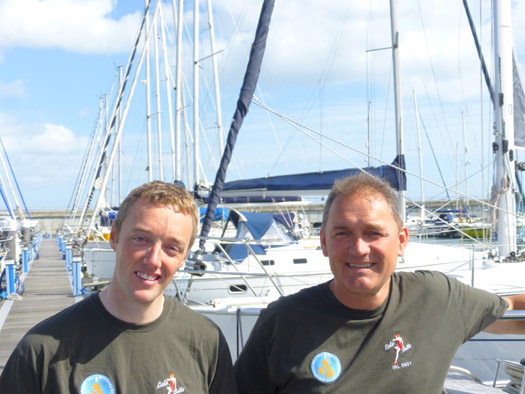
Brian Flahive & Liam Coyne back in Dun Laoghaire on the morning of their return from the finish of the Round Britain & Ireland Race. Photo: W M Nixon
As for the Laser Nats, they were at the end of August and another Ballyholme event, with Johnny Durcan of Royal Cork winning from Rory Fekkes of the home club, while the radials saw Annalise Murphy keep her hand in with a win from Cork's Cian Byrne.
After some rugged August weather, particularly on Ireland's East Coast, September was utterly blissful and it sweetly rounded out Dublin Bay Sailing Club's 130th season, the birthday being marked by a fairly epic dinner in the National YC. September also saw the conclusion of the slowly but steadily reviving Irish Sea Offshore Racing programme, with the end-of-season race from Pwllheli to Dun Laoghaire seeing Liam Shanahan's J/109 Ruth confirmed as the overall winner of the series. Among locally campaigned dinghies, meanwhile, Dun Laoghaire's keen Fireball Class kept its annual programme in lively shape, and the season drew a close with Barry McCartin and Conor Kinsella winning overall from Noel Butler and Stephen Oram.

ISORA Champion Ruth skippered by Liam Shanahan jnr from the National Yacht Club
Across country in Limerick, the CityOne dinghies and the traditional Shannon gandelows created in projects of the Ilen Boatbuilding School made their debut in the city centre on one of the last days of the Indian summer, and then they were put on display in a Naumachia in St Mary's Cathedral which was officially opened by Michael Noonan TD, and later formally visited by President Higgins.
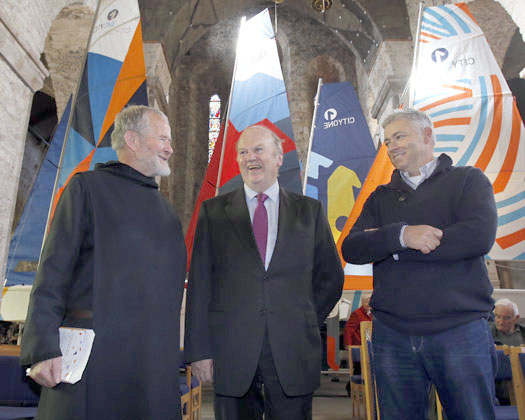
The hopeful new spirit of Irish sailing in 2014 was evident in St Mary's Cathedral in Limerick, when the CityOne dinghies built by volunteers in an inner city revitalisation project went on display in a Naumachia in the Cathedral on September 26th, after their first regatta on the Shannon in the heart of Ireland's City of Culture 2014. With the boats in the cathedral were (left) Brother Anthony Keane of Glenstal Abbey (Director, the Ilen School), Limerick's senior TD and Ireland's Minister for Finance Michael Noonan, and Gary MacMahon (right) Director of the Ilen School & Network for Wooden Boatbuilding. Photo: Press22
And then more vigorous winds returned in October, with the Freshwater Keelboat event on Lough Derg – originally just an exclusive Dragon thing – finding itself swamped with sixty and more boats from five classes and increasingly rugged conditions, such that only the Dragons and Squibs managed to get in any meaningful racing, with Neil Hegarty (RStGYC) winning the Dragons while James Matthews and Rob Jacob of Kinsale topped the Squibs.

Dragons in Autumn action on Lough Derg – Neil Hegarty (right) was overall winner from runner-up Richard Goodbody (left) Photo: Gareth Craig
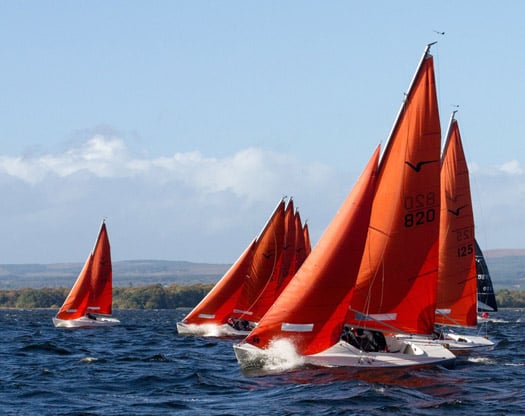
Squibs on Lough Derg – it may look like perfect sailing, but the top came off the weather very soon afterwads. Photo: Gareth Craig
The Student Yachting Worlds in La Rochelle in October had some hiccups in UCD's campaign for Ireland, but while they very narrowly missed the podium in a truly international event, they stayed put at fourth overall. And round in the Mediterranean, a record fleet for the Rolex Middle Sea Race from Malta saw entries soar through the 120 mark for the first time, and the 606 mile race had its first half in light breezes, but the second half was in pure Mistral, with people talking of "winds easing to 44 knots....." A Maltese-owned J/122 won, but second overall and first in her class was the Xp44 XpAct (Josef Schultheis) with a strong Irish emphasis in her crew including Barry Hurley, Andy Boyle, Kenny Rumball and Phillip Connor.
Soon afterwards, the Volvo World Race got under way with first stage from the Med to Cape Town, and Ireland's Justin Slattery on the winning boat on Leg 1. Back home, Autumn leagues had seen renewed enthusiasm as though people had suddenly re-discovered their sport, and the great sailing year of 2014 drew towards its close with the Lasers in Howth starting their 40th winter of annual frostbite racing. This means that HYC have now had a continuous sailing programme since April 1974, while across in Dun Laoghaire the DMYC Frostbite Series must be the most senior of all winter events. Winter Leagues attract more aficionados, with the popularity of the Dublin Bay Turkey Shoot in particular providing a forceful reminder that Dun Laoghaire is the principal sea access for a notably affluent and very large population in South Dublin. With the Turkey on its way, soon it's Christmas. And then the new Irish sailing season will begin on the blue waters of Sydney Harbour.
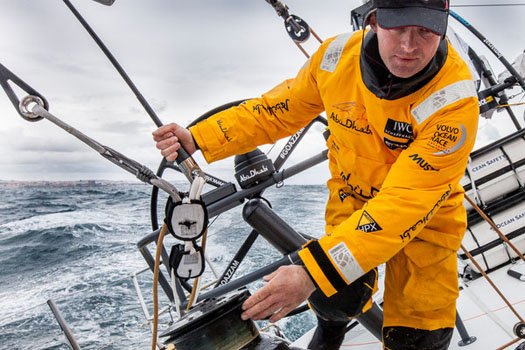
Justin Slattery on Volvo World Race 2014. Photo: Volvo Ocean Race
GP14 Hot Toddy Event At Newtownards Was Race Officer's 'Nightmare'
#gp14 – The GP14 Hot Toddy 2014 has been won by Ruan O'Tiarnaigh & Mel Morris writes Curly Morris. The forecast seemed promising with warm weather and some wind. However although the autumn warmth was there, Newtownards' sheltered position surrounded by low hills meant wind was minimal and a race officer's nightmare. The nice little breeze present while rigging disappeared but eventually a light westerly appeared and racing got under way in 3 -4 knots of wind around about 1.00 pm.
With a little more breeze on the left side of the track, boats coming in on port to the first mark did best with Dan & Hugh Gill and Ruan O'Tiarnaigh (standing in for the injured Ger Owens) with Melanie Morris rounded in the top positions, holding these for the next round. With the breeze slowly falling by the time boats started the run it was clearly going to be a long and difficult leg. The two leaders chose to gybe with the rest of the fleet sticking to starboard gybe and making better headway. Heading for the leeward mark Paddy O'Connor & Brendan Brogan seemed to have the lead, but J P McCaldin & Liz Copland and Alistair Duffin & Brendan McGrenagham rounding around 10th place sailed high to the area where the breeze was strongest on the beat and found enough extra wind to bring them into the leeward mark in first and second place. With the race being shortened at the leeward mark these became the finishing positions.
With little wind troubling the surface of the water nearly half the boats chose to take a break ashore, but most of them found they were unable to get back to the starting line when enough breeze appeared mid afternoon to start a second race. Fourteen boats made the start and were joined by J P who had made great efforts to get to the line from the shore. Again the breeze was best on the left and Keith Louden & Alan Thompson made a fast start and found the right way to the first mark followed by Ruan & Mel. With tighter reaches there was less opportunity for place changing. Ruan & Mel mounted a challenge on the second beat and were looking forward to the run when they realised the race was to be finished at the windward mark - a good decision with the wind falling again. Curly Morris & Laura McFarland held third with Katie Dwyer & Michelle Riley in fourth. The next boats coming up to the line received a shock when two boats suddenly appeared from the previously unfavoured right- Brenda Preston sailing with John McRobert and Newenham de Cogan & Andy Corkhill slipping into fifth and seventh positions.

On Sunday the early morning breeze again died but with a ripple appearing the fleet sailed slowly out to the race area for a start after midday for what was probably the calmest race of the weekend. Katie & Michelle with a great start got to the windward mark ahead of Dan & Hugh and held them off during the two downwind legs. With the wind again falling the beat was very difficult. Katie and Dan going up the middle found a big "hole" in the wind. Boats on the left did better with Ruan & Mel just managing to hold off a challenge from boats further to the left with Alistair and J P taking second and third. Alistair's performance was particularly note worthy - he collected a very expensive 720 at the gybe mark and then capsized on the last beat overdoing a roll tack! A memorable and entertaining end to a challenging but pleasant weekend.
GP 14 Hot Toddy Trophy
1 Ruan O'Tiarnaigh Gold 10 2 1 13
2 Keith Lowden Gold 5 1 7 13
3 Curly Morris Gold 6 3 6 15
4 J P McCaldin Gold 1 14 3 18
5 P O'Connor Gold 3 6 12 21
6 Shane MacCarthy Gold 4 8 10 22
7 Alistair Duffin Gold 2 26 2 30
8 Katie Dwyer Silver 19 4 8 31
9 Brenda Preston Bronze 21 5 13 39
10 Dan Gill Silver 9 26 4 39
11 Brian Andrews Bronze 14 11 17 42
12 Newenham de Cogan Silver 20 7 15 42
13 Peter Fallon Silver 13 26 5 44
14 Steven Nelson Silver 7 26 11 44
15 Michael Cox Silver 18 10 16 44
16 Tom Molloy Gold 12 9 26 47
17 Lawerence Baalham Bronze 8 26 14 48
18 Adrian Lee Bronze 16 13 26 55
19 Bill Johnson Silver 11 26 18 55
20 Gerard Brady Bronze 24 12 20 56
21 Simon Jeffery Bronze 26 26 9 61
22 Jack Buttimer Bronze 25 15 26 66
23 Joe Kelly Bronze 15 26 26 67
24 Anthony Hutton Bronze 22 26 19 67
25 Daniel Gallagher Silver 17 26 26 69
26 Mollie Egan Bronze 23 26 26 75
GP14s Return to Howth Yacht Club For Autumn Open Event
The Irish GP14 Class experienced Howth's two days of glorious weather, hospitality and sharp race management at Howth Yacht Club for their Autumn Open and Youth Championship.
Under the watchful eye of PRO Harry Gallagher, the fleet completed the full schedule of eight races, delayed for an hour or two on Saturday due to light winds, but completed in a steady Easterly force 3 on Sunday. There was something to test both the light crews and the heavyweights in super-flat seas and then fantastic surfing conditions.
The 2014 GP14 Autumn Open Champions are Niall Henry and Ossian Geraghty from Sligo. The wild men of the West just pipped Shane McCarthy and Damian Bracken by a point, followed two points adrift by the Under 23 Champion.
Sutton Dinghy Club dominated the Youth Championships with Daniel Gill taking the Under 19 Champion award and Eanna Moloney the Under 23 award.
Additional report below by Dan Gill
The 2014 GP14 Youth Championships kicked off to a slow start at Howth Yacht Club as racing was delayed due to lack of wind in the morning. The schedule provided two races for the seniors in the morning followed by another two in the afternoon for the Youth Championship.
The youth sailors, kindly ferried out to the racing area by Neville & Jean Maguire, waited eagerly as the seniors finished off their second race in gentle winds. With the changeovers complete, PRO Harry Gallagher quickly fired the five minute gun. The youthful enthusiasm of the sailors proved too much with two general recalls but finally got going, third time lucky. Two Sutton sailors, Callum Maher & Shane Mcloughlin miscalculating the race officer's signals and starting on the one minute gun provided the fleet with some humour as they continued towards the windward mark laughing amongst themselves.
With Eanna Maloney Lawless & Stephen Boyle rounding the windward mark first, the positions seemed set for the race with little place changing occurring around the racecourse. However the fleet battled it out on the upwind legs and the race finished up with Eanna & Stephen taking the bullet, Dan & Hugh Gill in second place and Gareth Gallagher & Donal McGuinness from Lough Foyle YC biting at their heels in third. By the time everyone had finished, the wind had dropped off and it seemed pointless to try and fit in another with stronger winds scheduled for Sunday.
Sunday began with sunshine and smiles all around as the forecast for stronger winds was correct. Racing kicked off with the first gun at 10:30. Strong winds and big swell provide the sailors with a difficult task navigating the race course with an extremely tight reach to the gybe mark and nice surf to the leeward mark with Dan & Hugh chasing the leaders Eanna & Stephen around the course but couldn't find the extra speed to catch them. Further back in the fleet they continued to fight it out until Edward Coyle & Colman Grimes of Skerries SC broke clear to take third. The last two races were fought hard by all in a strong breeze, no letting up with fierce competition on the points leader board. Gareth & Donal won race 3 from Edward & Colman with Callum Maher & Shane McLoughlin from Sutton pitching up in third place.
It all came down to the final race with Eanna, Dan, Gareth and Edward all possible winners. After a clean start Dan & Hugh rounded the weather mark followed closely by Eanna & Stephen. A tight top 3-sail reach saw Eanna pulling out over Dan and opening up yards as they powered into the gybe. Therein the battle for the Championship lay with Dan doing his best to catch the very quick Eanna providing the spectators on the committee boat and the waiting senior sailors with great excitement. At the last leeward mark Dan & Hugh secured inside position and held on to take the race win. Eanna however with 2 firsts and a second won the coveted GP14 Youth Championship of Ireland for the second year in a row. David Johnston & Alan Blay, also from Sutton, led the rest of the fleet home in third place. Many thanks to everyone who willingly gave their boats to the young sailors who happily returned them all without needing the wizardry of Alistair Duffin to put things right.
Pl Sail Helm Name Crew Name Club
1st 14116 Eanna Maloney Lawless Stephen Boyle SDC 1.00 1.00 (6.00) 2.00 10.00 4.00
2nd 13915 Daniel Gill Hugh Gill SDC 2.00 2.00 (7.00) 1.00 12.00 5.00
3rd 14080 Gareth Gallagher Donal McGuinnes LFYC 3.00 6.00 1.00 (8.00) 18.00 10.00
4th 14144 Edward Coyle Colman Grimes SSC (6.00) 3.00 2.00 6.00 17.00 11.00
5th 13977 David Johnston Alan Blay SDC (5.00) 4.00 5.00 3.00 17.00 12.00
6th 14055 James Hockley Alan Thompson LFYC 4.00 (5.00) 4.00 5.00 18.00 13.00
7th 14138 Calum Maher Shane McLoughlin SDC (11.00) 8.00 3.00 4.00 26.00 15.00
8th 13951 Sinead Dickson Katie Dwyer SDC 7.00 7.00 (10.00) 9.00 33.00 23.00
9th 13917 Michael Cox Josh Porter NSC (10.00) 9.00 8.00 7.00 34.00 24.00
10th 13207 Adrian Lee David Lappin YSC 9.00 10.00 9.00 (11.00) 39.00 28.00
11th 13902 Daniel Hopkins Nigel Sloan NSC 8.00 (11.00) 11.00 10.00 40.00 29.00
12th 14074 Cathal Sheridan David Cooke SSC (12.00) 12.00 12.00 12.00 48.00 36.00
13th 13882 Richard Gallagher Mark Ireland NSC (14.00 UFD) 13.00 13.00 14.00 DNF 54.00 40.00
Blackwater River Dinghy Cruise Voyages from Youghal to Villierstown
#dinghycruise – As previewed by Afloat.ie, last Saturday four visiting and five local GP14 dinghies crewed by 21 seafarers and two sea dogs set off from Youghal quay in County Cork at low water on the second annual Y2V Blackwater river cruise writes Norman Lee.
Molly the younger sea dog soon got the hang of scrambling to windward on almost every tack but sometimes preferred to stay to leeward to view the wildlife better and she probably set the tone for the many pre teen crews getting a taste for competitive/fun sailing in their respective dads racing machines.
The youngest boat was a beautiful Duffin built this year for Simon Culley and Libby Tierney of Blessington and the oldest, a lovely Bell Woodworking boat nearly 60–years–old and still in perfect fettle, now owned by 16–year–old Jack Nolan of Youghal.
One Mermaid and one Feva came along for the trip which included forming part of the backdrop for a society wedding in Ballintra House a classic yellow mansion, where a band serenaded us as we sailed by on a wide sweep of the river.
Villierstown Boating & Activities Club members at their brand new three week old facility on the riverbank couldn't do enough to make us welcome with hot soup tea and sambos and home cookies when we arrived and a massive fry on Sunday morning and free run of their facilities for the duration.
The value these guys have got from their sports council grant is unbelievable and great credit to all concerned and the welcome the GP visitors get in both Villierstown and Youghal makes it very possible this will be a well attended new addition to the annual GP circuit where the utility design of our boat comes to the fore.
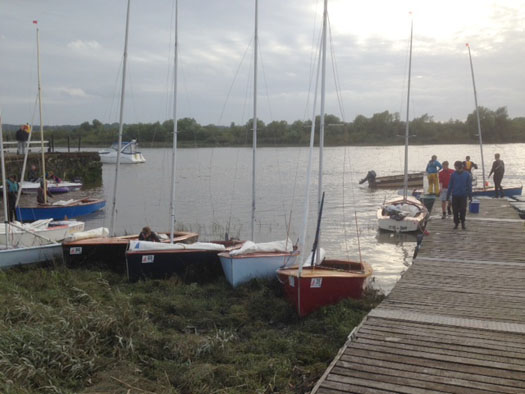
GP14s berth on the river bank
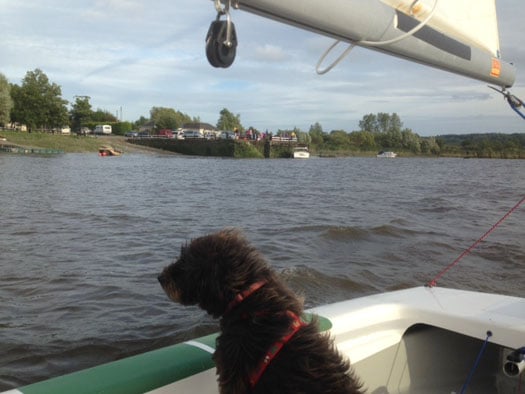
Molly, just one of two seadogs on the cruise keeps a look out
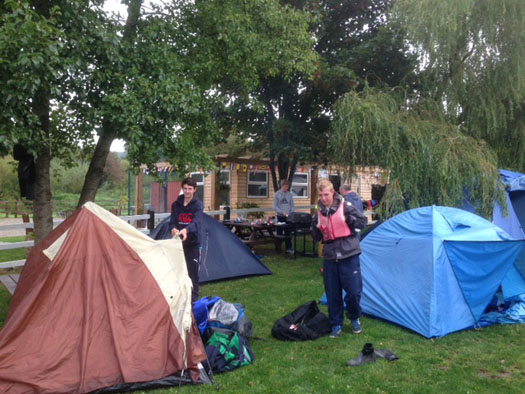
Getting the tents ready at the new Villierstown clubhouse
More on dinghy cruising possibilities here: Is 'Adventure Sailing' a New Tack for Dinghy Sailors?
Sailing in Youghal Boost From Blackwater Voyage to Cappoquin
#youghal – The Munster Blackwater is one of Ireland's mystery rivers writes W M Nixon. Despite comparisons to the Rhine, it keeps much of its long and beautiful length well hidden. And even when it reaches the sea at Youghal, that ancient seaport town manages to be shaped in such a way, with a clutter of waterfront buildings obstructing the view, that it's often impossible to see the water, and whether it's river or sea or both.
As for seeing the boats based there, it's hit or miss. They may be hidden away in muddy little docks, or lying to moorings in the strong tidal stream, or else in the anchorage across the estuary on the east shore at Ferry Point. One way or another, they're well scattered. So anyone voicing the ambition of making Youghal "the Kinsale of East Cork" has a mountain to climb.
But a Youghal schoolboy, Adrian Lee, has come up with a good idea for promoting sailing in Youghal. And while he may not be climbing any mountains, he's planning to take a small fleet of boats – mostly GP 14s - sailing towards the hills and high lands this Saturday, going sixteen miles up the Blackwater, to Cappoquin in West Waterford nestling under the handsome Knockmealdown Mountains.
He knows it can be done, as he has tested the course himself. He bought his first GP 14 four years ago, aged just twelve, with funds he'd saved - "mostly confirmation money". That was an old ex-Naval Service glassfibre boat, which he refitted and learned to sail, mostly self-taught with regular crew Edward Coyne. More recently he up-graded to the creme de la crème, a Duffin boat, and now he's seriously into racing. But he rightly reckons the way to get Youghal interested in sailing the sea is by a cruise-in-company up the incomparable Blackwater to Cappoquin.

Looking downriver from Villierstown, where the Youghal flotilla plan to overnight on Saturday. Photo: W M Nixon
It has become a two day event this coming weekend, August 30th & 31st, with the enthusiastic support of the Irish GP 14 Association's Norman Lee of Greystones. Norman has already been down to Youghal to sail the course to Cappoquin, and the hope is that maybe ten GP 14s will gather at the waterfront at Youghal at noon on Saturday, and once everyone has got themselves organized, they'll set off together upriver to Cappoquin with a support group including visiting boats from Dungarvan, notably a cruising Mermaid.
They'll take the tide all the way upriver on Saturday afternoon, but as they can get no further with masts stepped than the old railway bridge at Cappoquin, they'll head downriver to pretty Villierstown on the east shore. There, the local sailing and boat club is into its stride with a new clubhouse and a pontoon acquired second-hand when Dungarvan SC were recently up-grading their pontoon facilility in that bustling West Waterford town.
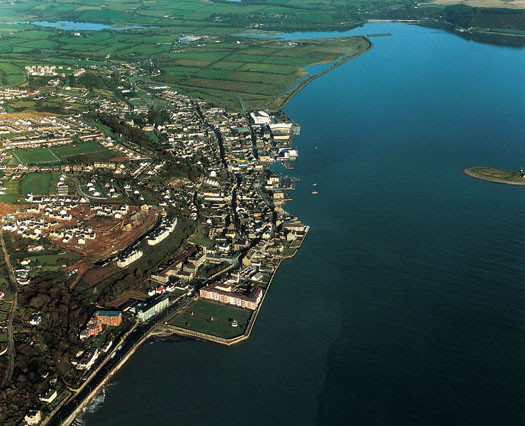
Looking north across Youghal, the aerial view indicates how the crowded waterfront can make it difficult to see the sea. Photo Kevin Dwyer courtesy ICC.
The flotilla will overnight at Villierstown, then they'll take the morning ebb on Sunday to head on downriver, hopefully to reach Youghal at a civilised hour for lunch, while also providing plenty of time for an easy journey home for those who have bought their boats some distance to take part in what could well become a memorable annual event.
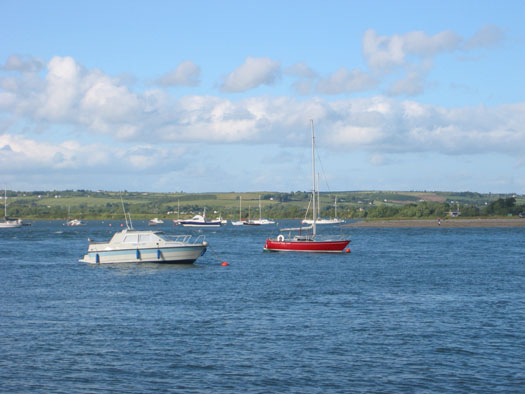
A scattered fleet – boats based in the Blackwater Estuary at Youghal are either on tide-rode moorings off the town (foregound), or in a more sheltered area north of Ferry Point (beyond) on the east side. Photo: W M Nixon
McGuinness Brothers Take Top Irish Result At GP14 Worlds
#gp14 – Three race wins were enough for Britain's Ian Dobson and Andy Tunnicliffe was more than enough to wrap up the GP14 World Championship on Strangford Lough yesterday.
Although British entries took the top five places in the 100–boat fleet, Irish boats occupied the next five. Donegal brothers John and Donal McGuinness from Moville Sailing Club were the top Irish placed crew in sixth overall, counting six top ten results in the eight race series. Full results here


























